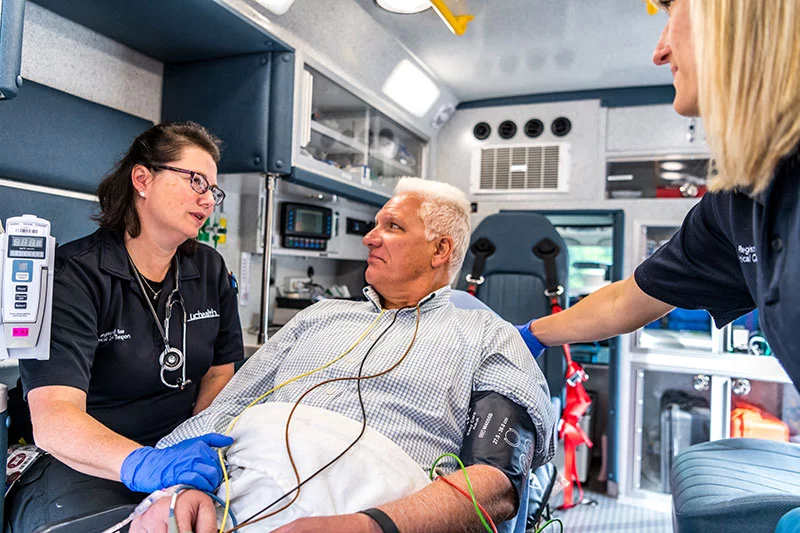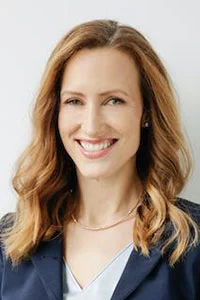
The Centers for Disease Control and Prevention estimates that 3 million older Americans visit emergency rooms each year because of falls. That number does not do justice to the damage from these mishaps. Many older people who fall spend time in the hospital for fractures and other serious injuries. They often can do less when they return to their homes or must move to a nursing home or assisted living facility. More than 40,000 older adults died in 2023 because of preventable falls.
By one estimate, non-fatal falls cost the health care system $80 billion in 2020.
These statistics call for answers to two questions: why do these falls happen, and what can health care providers, family members and patients themselves do to prevent them? Innovative solutions could spare people from injury and death, preserve their quality of life and save valuable health care resources for other pressing needs.
Dr. Bucky Ferozan, an emergency medicine doctor at UCHealth Medical Center of the Rockies, sees the problem every day. Older adults account for about 40% of all ER encounters at his hospital, and falls are responsible for nearly one-third of those. He said it’s important to learn why a person falls because one fall sharply increases the risk of another.
“Finding the reasons for an elderly person’s fall is much more nuanced than saying, ‘Oh, the patient felt dizzy and they tripped over a curb,'” Ferozan said. “You have to get into the nitty-gritty.”
The factors that contribute to falls include malnourishment, medication interactions, frailty, depression, dementia and vision problems – or simply a bunched-up rug lying in a walking path, Ferozan said.
Ferozan created a program in 2019 at UCHealth Longs Peak Hospital to dig into those details. It includes a screening tool to identify patients at the greatest risk for falling. Those patients and those who come to the ER after a fall get a geriatric consult that involves physical therapists, pharmacists, social workers and others focused on a common goal: pinpoint what caused the fall and find ways to prevent another. A geriatric dashboard keeps track of fall-related data.
A plan for virtual fall prevention that builds on earlier research
Ferozan is now collaborating with fellow emergency medicine specialist Dr. Elizabeth Goldberg on a study, called e-GAPcare, that adds a twist to his geriatric consult. Goldberg, an associate professor of Emergency Medicine at the University of Colorado School of Medicine who treats patients in the emergency department at UCHealth University of Colorado Hospital, leads the new trial.
The study, now in its formative stages, tests the possibility of using telehealth consults with physical therapists and pharmacists to help older people coming to the ER at Medical Center of the Rockies because of falls.
The e-GAPcare trial extends a concept that Goldberg devised and tested with a clinical trial during her post-doctoral fellowship at Brown University’s Center for Gerontology & Healthcare Research in Providence, Rhode Island.
The concept, called GAPcare (Geriatric Acute and Post-Acute Fall Prevention), used a team approach to treat older adults who suffered falls that sent them to the ER. After medical treatment for their injuries, patients in the study saw a physical therapist and pharmacist who looked for possible underlying factors that contributed to the fall.
For example, a physical therapist might look for balance or gait problems, while a pharmacist might review a patient’s medication list for drug side effects or interactions that could cause dizziness or cloud their thinking.
The GAPcare pilot study earned high satisfaction marks from both patients and providers. Patients did not stay in the ER longer than those who got standard care, and had 66% fewer repeat visits for falls compared to their trial counterparts.
Goldberg launched a follow-up trial, GAPcare II, funded by a five-year Paul B. Beeson Emerging Leaders in Career Development Award from the National Institute on Aging. GAPcare II continued the multidisciplinary approach to fall prevention and added technology to the mix.
Patients received Apple Watches capable of detecting falls, a boon for the difficult task of gathering reliable data about how often falls occur (the CDC notes that less than half of older people who fall let their doctors know about it). Goldberg said her team is wrapping up its data analysis from GAPcare II and expects to publish the results later this year.
Telehealth expands access for patients – and answers questions raised by GAPcare II study
The GAPcare II study yielded many insights, she said. An important one – and a key to designing the e-GAPcare trial – came early on when she took her idea to doctors and nurses at small hospitals.
“One of the main critiques was, ‘We don’t have physical therapists or pharmacists,’” she said. Some hospitals that had those professionals worried they didn’t have enough capacity to help all of their other ER patients. Other barriers included financial constraints and a lack of patient volume.

However, Goldberg said she also heard from physical therapists and pharmacists who said they could use telehealth to deliver their care, a skill they and many other health professionals developed during the COVID-19 pandemic that began in 2020.
“We asked them about telehealth and how they had implemented it, and it became clear to me that it’s a huge patient satisfier,” Goldberg said.
For example, telehealth helps patients with transportation challenges and those who are reluctant to leave their homes. An older patient who visits the ER after a fall could have a virtual session with a physical therapist instead of going to another facility for care.
“We heard from folks all around the country that GAPcare is great, but only for places like Level 1 trauma centers and academic medical centers that can invest in really broad resources,” Goldberg said.
A happy connection between two fall-prevention leaders spurs e-GAPcare study
When Goldberg moved from Rhode Island to the Anschutz Medical Campus in 2022, she met Ferozan and learned that he shared her commitment to a team-based approach to fall prevention. They agreed to work together on a virtual model at Medical Center of the Rockies that became e-GAPcare.
The study works like this. When an older adult comes to the ER at Medical Center of the Rockies after a fall, research staff will ask them if they want to take part in testing the e-GAP care model. The patients will meet virtually to review their medications with pharmacy residents on the University of Colorado Anschutz Medical Campus, trained by Sunny Linnebur, a clinical pharmacy specialist for the UCHealth Seniors Clinic – Anschutz Medical Campus. Linnebur is also a professor of clinical pharmacy at the Skaggs School of Pharmacy and Pharmaceutical Sciences.
Staff physical therapists with Medical Center of the Rockies will also meet virtually with the study patients to assess their fall risk and, if needed, develop a plan to address gait and balance problems and other fall risks. In addition, a safety and monitoring plan aims to reduce patients’ fall risk while they do activities prescribed by their physical therapist. A research team at Medical Center of the Rockies will “shadow, assist and support” patients to prevent another fall while they complete their telehealth session at the hospital, Goldberg said.
Goldberg and Ferozan hope to begin recruiting patients this fall. Goldberg believes the telehealth aspect of the study addresses a fundamental challenge, not only for at-risk patients, but for the health care system as a whole.
“There are huge health disparities in rural communities,” she said. “Rural communities are older; they have longer distances to travel to get to centers that have all the specialties. As a result, they get worse outcomes a lot of times. So it has been exciting to think about how we bring those resources to them.”
Additional tactics for fall prevention
Ferozan believes e-GAPcare is “definitely doable” for ERs handling heavy patient volumes without the immediate services of physical therapists and pharmacists for consults. But he wants “multiple layers of redundancies” and resources for patients at risk for falls.
Examples of these other ideas include:
- Enlisting community paramedics to visit patients who return home and check for hazards like loose handrails – an initiative previously used before funding issues sidelined it.
- Using UCHealth’s virtual assistant, Livi, to push community resources about fall prevention to patients via a QR code on their ER discharge paperwork. Ferozan said he and Goldberg have worked with the UCHealth Care Innovation Center team to develop a falls module for Livi and start testing the technology with ER patients.
- Providing discharge instructions with larger type.
- Sending reminders about resources to patients on the My Health Connection
On a broader scale, the University of Colorado Multidisciplinary Center on Aging recently received a grant to start a falls prevention coalition to connect like-minded organizations, develop fall-prevention strategies and make policy recommendations to the state.
Dr. Thomas Johnson, assistant professor in the Division of Geriatric Medicine, who practices in the UCHealth Seniors Clinic, leads the coalition, along with Jodi Waterhouse, director of strategic partnerships and planning for the Multidisciplinary Center on Aging.
“It’s the first time our state has had a falls coalition in many years,” Goldberg said, adding that she and Ferozan serve as experts on the team.
A focus on older adult-centered care in the ER
Ferozan also noted that UCHealth’s Medical Center of the Rockies, Poudre Valley Hospital, Greeley Hospital and Longs Peak Hospital are all accredited to treat geriatric patients through the American College of Emergency Physicians. That is another key part of the effort to improve care for older patients.
There are three levels of accreditation for ERs. So far, Medical Center of the Rockies and Greeley Hospital are at level 3, which requires at least one geriatric-trained physician and nurse. Poudre Valley Hospital and Longs Peak Hospital are at level 2, which requires other geriatric-trained staff members and a standardized protocol – the hospitals chose to address falls.
Level 1 accreditation requires that hospitals build an integrated system that helps them transition older patients from the ER to the most effective care for falls or any other condition. Ferozan said the hospitals aspire to reach that level by not only providing quality medical care, but also taking part in research, like the e-GAPcare study, and building a dashboard that Ferozan already uses to comprehensively track data from the ER and determine whether the care patients receive is effective.
Ferozan sees e-GAPcare as an important part of the fall-prevention puzzle.
“I feel that the technology, if used correctly, could have a profound effect on patients’ lives,” Ferozan said, noting that he sees too many patients sustain hip fractures and see their health quickly spiral downward.
“We really want our geriatric patients to thrive and be able to do the things that they want to do,” Ferozan concluded.
